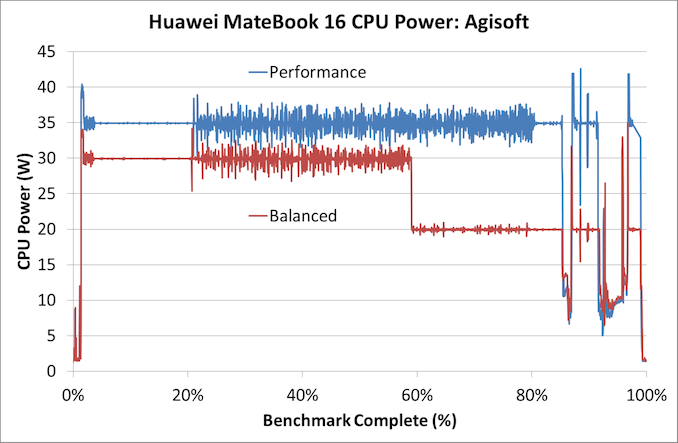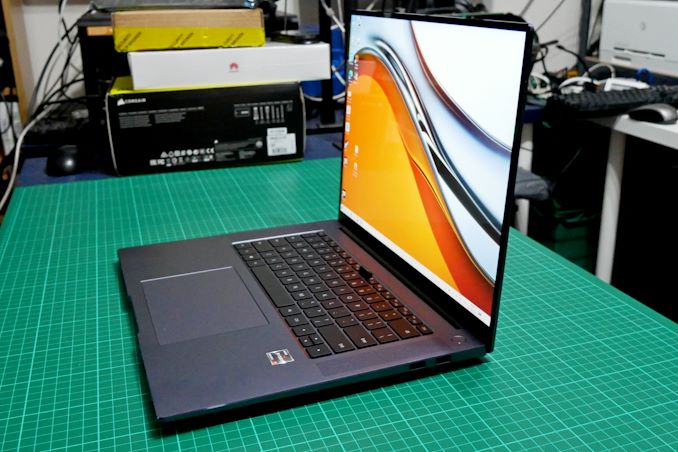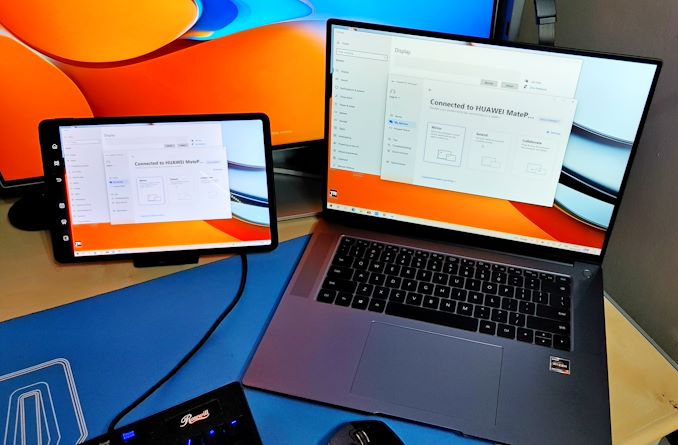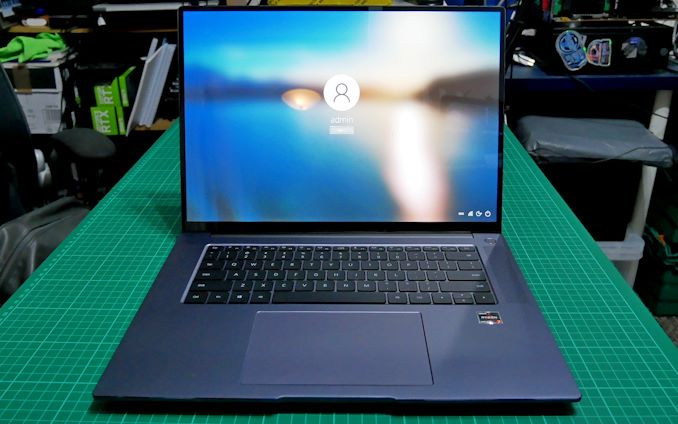The Huawei MateBook 16 Review, Powered by AMD Ryzen 7 5800H: Ecosystem Plus
by Dr. Ian Cutress on October 20, 2021 8:00 AM EST- Posted in
- Laptops
- AMD
- Huawei
- Matebook
- Ryzen
- Zen 3
- MateBook 16
- Huawei Share
- Ryzen 7 5800H
Huawei: Building its Ecosystem
From the 30000ft view, I’m a fan of notebooks that promise good power and battery life at the expense of graphics. As a journalist, when I’m on the move I need something that’s going to be easy to carry, easy to work on, and has enough juice to last me through the day. Naturally, some might think that I should pivot to one of the Snapdragon or Chromebook devices, but alas I have some software in my daily toolset that doesn’t work on either, so until then, I’m still focused on devices built with AMD or Intel.
With that brief, the MateBook 16 on paper fits the bill. It’s a 16-inch device that shuns discrete graphics in favor of a larger battery, lighter unit, and slimmer design. The IPS display is an odd resolution (2520x1680), but the 3:2 aspect ratio is appreciated for the sort of text-heavy writing and research I tend to do. It has Type-C and Type-A ports, a full-sized HDMI port, a large smooth trackpad, and an off-center power button with an excellent fingerprint sensor inside. So it’s a shame that the pop-up camera makes for nasal meetings. Overall, at 2 kg, it isn’t the lightest in its segment (the LG Gram 17 is 1.5kg), but it is half the price, and comes with a 45W-class processor.
When the CPU Isn’t What You Think It Is
So here’s where we get into some of the discussions around performance. The Ryzen 7 5800H is a good choice for this class of device: eight Zen 3 cores at high frequency with Vega 8 graphics. While the graphics aren’t great for regular 16-inch devices that often have discrete graphics, the CPU has grunt. However, the Ryzen 7 5800H is a 45W-class processor, and so reading a specification sheet you would expect that level of performance. Huawei runs the processor at 35W instead, which is well within the spec for this part, however nowhere on the box does it say as much. There are tradeoffs with the lower power setting, such as slightly reduced performance in exchange for some battery life, but also less dependency on cooling and a lighter chassis. Huawei does offer a performance mode, when the charger is plugged in, however this just means the 35W mode is infinite, whereas in regular mode (unplugged or plugged in) may only stay at 35W for a limited time based on temperature/efficiency.

Performance was 6% quicker to complete over 20 minutes
So if you were to buy this laptop, or any laptop for that matter, should you expect the processor to run at the power given by the processor manufacturer? Almost every laptop processor is offered to the laptop manufacturer with a configurable power option, allowing them to optimize for the chassis design. If it is adjusted from the CPU default, then should the customer know about it? As of right now, and every OEM is guilty of this, no laptop ever mentions when the CPU is configured for the chassis at a lower specification point than the default.
This drives me somewhat insane, as someone who likes to know exactly what performance I’m getting from a device. Now it might seem a bit oblique to talk about this specifically during one particular review, but it’s an endemic problem across all laptop manufacturers. It wouldn’t take much to say ‘Device X (35W)’ in the specification page. Unfortunately sometimes the people writing those specification pages for retail or for websites aren’t connected to the engineers tuning the device at all. So we’re left with automatically assuming the processor manufacturer specifications, which in this case, isn’t correct.
The plus side, I guess, is that laptops should be reviewed to know their real performance!
Huawei MateBook 16
The goal of the MateBook 16 seems to be that it offers one tool for anyone investing in Huawei’s ecosystem, combining laptop, smartphone, tablet, or anything else. Using features like the Huawei Share was actually quite easy, to move files, or to extend a workspace. If I already take a laptop and a 13-inch Type-C wired display with me when I go on a work trip, then migrating that display with a wireless connection, as well as doubling it up as a standalone tablet, isn’t so much of a leap. However, when it comes to display sharing or extending, input lag will be a thing for anyone looking to do some gaming.
That being said, the 16-inch size of the unit isn’t ideal when faced with modern-day economy travel. Even as small as I am at 5’5, pulling a 13-inch laptop in an economy seat is sometimes fraught with issues (especially as the person in front leans back and catches your screen, cracking it), let alone using a 16-inch. To get the best in that light, you need to be on a bulkhead seat, or be in a business-class seat.
Therein lies a bit of a dilemma. I would imagine someone using a business class seat that was paid for would have access to $2000-$3000 for a work device. The Ryzen 7 5800H in this review is 1199 Euro or £1000 GBP (USD$1150 pre-tax), which marks it more as an entry-business notebook. As a business device, where graphics aren’t needed and you’re happy with the size, then the MateBook 16 works well with its strong display, CPU, and reasonable battery life, but the DRAM/storage might be limiting. At 16 GB / 512 GB, this does teeter on the barely acceptable limits. But this all combines into that lower cost.
For comparison, at Dell the similar device is the Inspiron 16. Around the same price, it offers the Intel Core i7-11800H, a 16:10 slightly higher resolution screen, same DRAM/storage, similar battery, TB4, full keyboard, but is also slightly thicker for the same weight, and doesn’t have dual front-facing speakers. Lenovo’s IdeaPad Creator 5 16 has the Ryzen 5 5600H, 1600p display, same DRAM/Storage, comes with a GTX1650, and a slightly smaller battery, at around 10% higher cost. This market is bigger than you might think, with most of the major players having at least one offering around this price, and the minutiae come down to exact features vs favoring one brand over another.
Overall, it isn’t the device for the person that I am – it’s just a bit too physically big, and ultimately I can feel the difference between lugging a 2 kg device around a trade show compared to a 1.5 kg device. But for those that it fits, the building blocks are there for a very easy-to-use ecosystem. I wait for a version where Huawei ditches that camera though.













87 Comments
View All Comments
Samus - Wednesday, October 20, 2021 - link
Every notebook I've ever had with a dGPU has been useless for portability. It isn't that they are bulky or heavy anymore, that issue has been overcome, even though they still run hot.But they get terrible battery life whether using the dGPU or not - the battery is physically tiny to make room for all the shit they cram into it.
My last two notebooks have been iGPU Intel's but now that we have companies considering additional headroom on the Ryzen GPU that would likely beat anything Intel has.
Prestissimo - Thursday, October 21, 2021 - link
Spend more money on laptops with 90-100WHr Battery + non-4K Screen + Ryzen 5000H/HS CPUs, and you'll find that they are lightweight, portable, cool on idle, and have excellent 7-8 hour battery life.You get what you pay for.
EasyListening - Friday, October 22, 2021 - link
AMD's partnership with TSMC puts it at the head of the pack in electrical efficiency. TSMC's manufacturing technology is superior to Intel's and Samsung's. Intel is still struggling with 10nm, and Nvidia screwed itself by ticking TSMC off (tried to pressure them on pricing), leaving it no option but to go with Samsung and it's poor yields, and that much, everyone knows. What might not be obvious is that AMD put together a dream team to launch Lisa Su's tenure as CEO. Papermaster would have known Su at IBM (she was head of research). Jim Keller and Raja Koduri are both former AMD. The three of them were at Apple, making the iPhone 4. They probably trained the team that produced the M1. Koduri is now at Intel, and Papermaster is still at AMD. Keller is doing his thing, blowing minds wherever he goes. AMD is not inferior, it is just much smaller. With TSMC's help, AMD might look like a behemoth, but actually, it's more like a boutique chip design shop. And Su is a genius who should have won a Nobel Prize for her pioneering work on silicon doping (made it possible to use copper instead of aluminum traces in semiconductors). Her PhD from MIT is in semiconductor manufacturing. Intel may be bigger, but AMD punches way above it's weight class. It's simply an amazing company, and we can all expect nothing but the best from them going forward. The turnaround of AMD is the best tech story of this era.lemurbutton - Wednesday, October 20, 2021 - link
Another laptop review without industry-leading Macbooks. Come on Anandtech.The_Assimilator - Wednesday, October 20, 2021 - link
That's because it's a review, not a comparison, Captain Genius.hlovatt - Wednesday, October 20, 2021 - link
But it does compare to other laptops in the performance tables. So why not include MBA and it’s M1 processor. It would be very interesting to see how they stack up.dontlistentome - Wednesday, October 20, 2021 - link
It compares if you're running Chrome or a benchmark set. MS Excel models or a ton of other stuff? Not so much.philehidiot - Wednesday, October 20, 2021 - link
The price disparity means they're in different ballparks. I like my Mac and it's OS. But I'm not looking for a new one at the price their decent systems come in at.lemurbutton - Thursday, October 21, 2021 - link
M1 Macbook Air is $850 on sale frequently.fishingbait15 - Friday, October 22, 2021 - link
That $850-$1000 M1 MacBook Air has a 13' screen, 8 GB RAM, 256 GB storage, has 1/8 of its GPU cores disabled for no particular reason and only supports 1 external monitor. Even if you leave aside the massive amount of Windows-only and x86-only software AND its complete and total lack of upgradability - it doesn't even support an eGPU despite having a Thunderbolt 4 port - there are tons of reasons not to consider the M1 MacBook Air a relevant comparison. Yes, it runs slightly faster but it is an entry level device. This isn't. You would need to compare it to the 13' MacBook Pro ... which costs a couple hundred more yet still has many of the same downsides (all the GPU cores work on it at least).